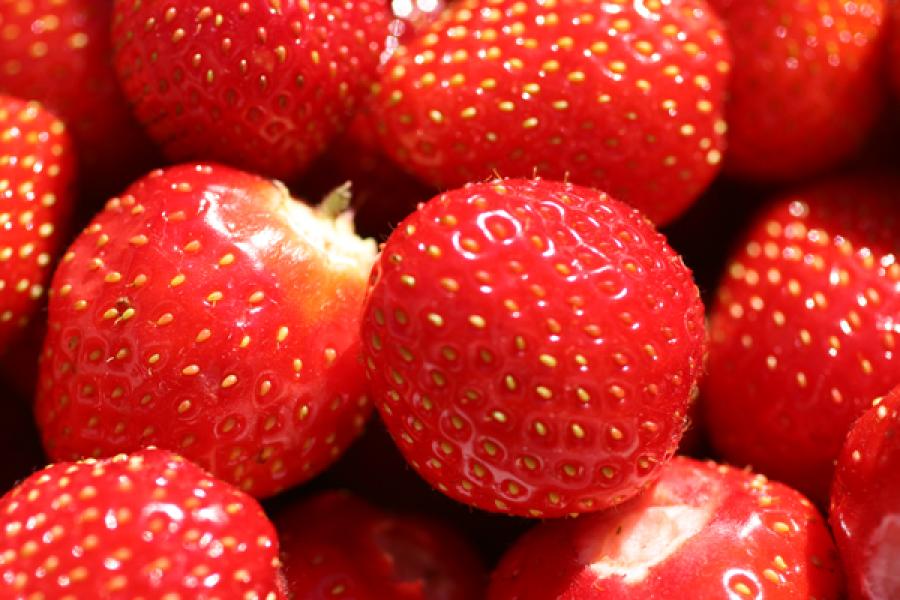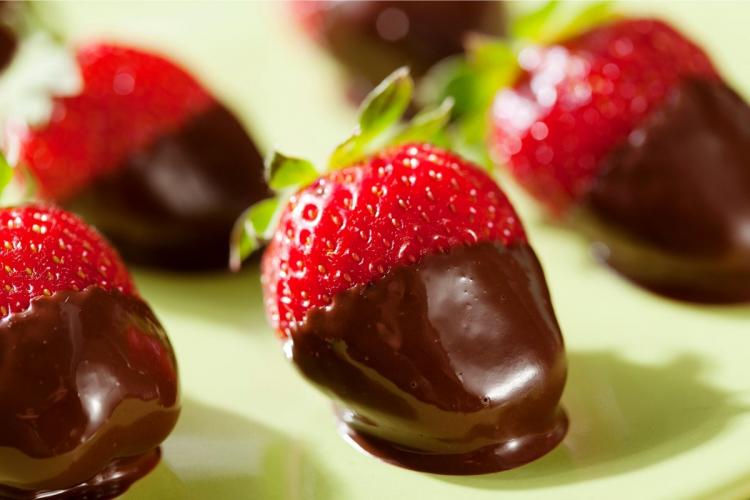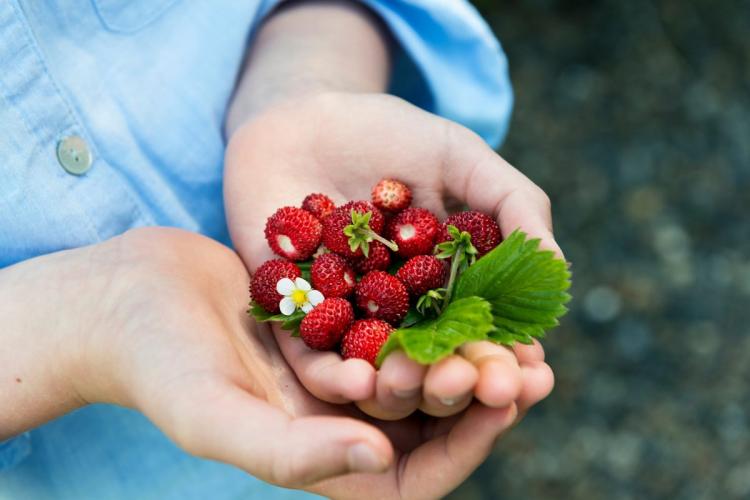Strawberry
Strawberries deliver a vibrant burst of flavor that's as nutritious as it is versatile.
Strawberries, with their vibrant red hue and juicy sweetness, have captured hearts worldwide, making them one of the most beloved fruits.
Strawberry
The strawberry, with its scientific name Fragaria × ananassa, belongs to the Rosaceae family. Its journey began in ancient Rome, but the modern strawberry is a tale of two continents, where a chance hybridization in the 18th century between North American and Chilean varieties gave birth to the fruit we adore today.
Facts
Strawberries are a powerhouse of vitamins, minerals, and antioxidants. Rich in vitamin C, manganese, folate, and potassium, they're also a great source of fiber. Their high antioxidant content, including anthocyanins, helps combat oxidative stress.
How to identify strawberries
The strawberry is a heart-shaped fruit. Its form tapers from a broad base to a pointed tip. The surface is dotted with tiny seeds, embedded into the pulp. They have a characteristic flavor and aroma, being sweet to the bite with a refresing acidity at the end.
The strawberry plant is a low-growing perennial. Its leaves are trifoliate, bright green, glossy and have serrated edges. Flowers are white with a golden center. The fruit itself is not a berry but an aggregate accessory fruit. The fleshy part is derived from the receptacle that holds the ovaries. Each of the tiny seeds (achenes) on the outside is actually one of the ovaries of the flower, with a seed inside it.
The cultivated strawberry is big and smooth skinned. The wild strawberry is small and more aromatid; does not require hulling.
How to use and store srawberries
Strawberries can be enjoyed fresh, frozen, dried, canned or in jams and preserves.
When buying fresh strawberries, search for berries that are bright, firm, and have a vibrant red color, ensuring they are ripe and flavorful. The caps should be fresh and green, indicating freshness. Avoid berries with signs of mold, bruising, or dampness, as these can indicate they are past their prime.
To store fresh strawberries, keep them in their original container or a paper towel-lined container in the refrigerator. Do not wash them until you're ready to eat them, as moisture can promote mold growth. Fresh strawberries typically last in the refrigerator for 2-3 days. For extended storage, consider freezing them.
Strawberries can be processed into a variety of products, including jams, jellies, syrups, and even wines. Their natural pectin content makes them ideal for preserves.
Frozen strawberries are a convenient option, offering the taste of fresh strawberries year-round. They are perfect for smoothies, baking, or cooking. To store them, follow general guidelines for frocen produce.
Freeze-dried strawberries retain much of the flavor and nutrients of fresh strawberries but in a crunchy, shelf-stable form. They are great for snacking, topping cereals, or adding to baked goods. Store freeze-dried strawberries in a cool, dry place. Once opened, transfer them to an airtight container to keep them crunchy. They can last for several months when stored properly.
Canned strawberries offer a convenient, shelf-stable way to enjoy the fruit's sweet flavor outside of its natural season. They are typically preserved in a sugar syrup or natural juices, which helps retain their taste and texture over time. After opening, if not used immediately, it's best to transfer the strawberries and their liquid to an airtight container to maintain freshness and prevent any metallic taste from the can. Canned strawberries can last for years when stored in a cool, dry place. Once opened, they should be refrigerated and used within a week for the best quality and taste.
Strawberry jam and preserves allow you to enjoy the flavor of strawberries in a spreadable form. They are perfect for toast, desserts, and even as a sweet addition to some savory dishes. Unopened jars of strawberry jam or preserves should be stored in a cool, dark place. Once opened, they should be refrigerated and typically last for up to two months.
Strawberry syrup is a sweet, concentrated form of strawberries, ideal for flavoring drinks, desserts, and pancakes. Treat in a similar form to jams.
Cooking with strawberries
Strawberries can be eaten raw or used to add a sweet and tangy flavor to salads, desserts, smoothies, and sauces. Their versatility makes them a staple in both sweet and savory dishes.
Always wash strawberries gently under cold water right before you plan to use them. This helps remove any dirt or residues without soaking the fruit, which can make it mushy. To remove the green leafy cap and the white part (hull), you can use a paring knife or a special strawberry huller. This step is essential for most recipes, except when presenting strawberries whole for decorative purposes. Strawberries can be sliced in halves, quarters, or thin slices depending on the recipe requirements. Thin slices are perfect for garnishes, while halves and quarters are great for salads and desserts.
Enjoy strawberries on their own as a refreshing snack. Toss them into fruit salads for a burst of color and flavor. Slice them onto cereals or yogurt for a nutritious breakfast. Add sliced strawberries to spinach or mixed green salads for a touch of sweetness. They pair wonderfully with balsamic vinegar and goat cheese. Use them in salsa, combining with ingredients like avocado, onion, and cilantro for a sweet and spicy mix that's perfect with grilled chicken or fish.
Strawberries are a classic topping for cakes, tarts, and pastries. Their vibrant color and sweet flavor complement the richness of these desserts. Strawberry is one of the top flavors of ice cream. Dip strawberries in melted chocolate and let them harden for a simple yet luxurious treat, ideal for special occasions or as a gift.
Blend strawberries into smoothies for a healthy, flavorful drink. Muddle them in cocktails or mocktails for a fruity twist. Strawberry mojitos and margaritas are popular choices. Make strawberry lemonade by adding pureed strawberries to your regular lemonade for a sweet and tangy refreshment.
Cook down strawberries with sugar and lemon juice to make a thick jam or compote. This can be spread on toast, swirled into oatmeal, or used as a topping for pancakes and waffles. Puree strawberries to make a sauce for drizzling over desserts or savory dishes. A strawberry balsamic glaze, for example, can add a sophisticated touch to grilled meats.
Equivalences and substitutions
9-10 medium straberries make 1 cup, whole, and 3/4 cup if sliced. 300g frozen strawberries fill about 2 cups whole and a little over 1 cup if puréed. 300g os strawberries in syrup fill abour 300ml.
If a recipe needs fresh strawberries and you fon´t have them, you can substitute strawberries with the same amount of:
- raspeberries, loganberries or tayberries (red color)
- blueberries (purple color)
You can also substitute 1 cup chopped strawberries with 1 cup of guava pulp, although it has a more orangeish color, or peeled and chopped kiwi fruit, which is a bit more tart and green.
Strawberry preserves can be substituted with the same amount of raspberry or blueberry preserve, guava paste or with other tropical fruit preserves.
Cultivation
The strawberry plant is hardy and adaptable, thriving in a range of climates and conditions, though it favors well-drained soil and ample sunlight. They can be grown in traditional beds, containers, or hanging baskets. The plant spreads through runners, slender stalks that grow outward from the main plant, touching down in nearby soil to root and form new plants, thus expanding its domain in a garden or container.
The cultivated strawberry is available all year as it can be grown in greenhouse, but its season peaks in the summer. The wild strawberry is available in late spring and during the summer.
(fragaria x ananassa, fragaria virginiana, fragaria chiloensis,)
Rosaceae
Strawberry, strawberries.
French: Fraise.
German: Erdbeere.
Italian: Fragola.
Spanish: Fresa, fresón.
Portugués: Morango.



